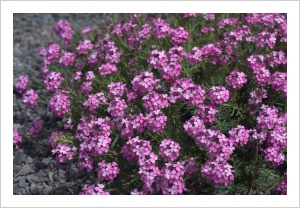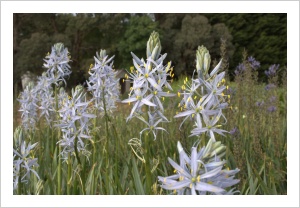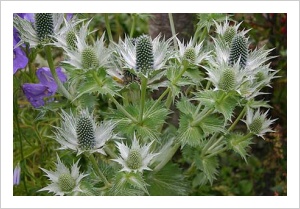Ellen Willmott
Two plants flowering in the garden at the moment remind me of Ellen Willmott, a woman who inherited two nineteenth century fortunes, one from her father and another from her godmother, and spent the lot on her gardens and died in penury. She received Warley Place in Essex in the 1890s when her father died and later bought a property in Savoy and another estate in Liguria in northern Italy with part of a substantial inheritance from Countess Helen Tasker. At one time Willmott employed more than a hundred gardeners. A tough boss, she would sack any gardener on the spot if she found a single weed growing in his area of responsibility.
 A deep pink flowered stonecress, Aethionema ‘Warley Rose’, named for Willmott’s garden, is the most beautiful and long lived plant in the genus. I grow it in a dry scree bed and in an another dry area mostly dedicated to small jewels of the bulb world. ‘Warley Rose’ flowers for a couple of months when the winter and early spring flowering bulbs have finished their display. It makes a low growing evergreen sub-shrub some 10cm tall by 40cm across which is simply smothered with flowers. The genus is centred on Turkey and whilst I’ve grown several other species most are so insignificant they are only grown by enthusiasts in the alpine and rock garden societies. Aethionema grandiflora is the exception as it has particularly attractive heads of large soft pink flowers.
A deep pink flowered stonecress, Aethionema ‘Warley Rose’, named for Willmott’s garden, is the most beautiful and long lived plant in the genus. I grow it in a dry scree bed and in an another dry area mostly dedicated to small jewels of the bulb world. ‘Warley Rose’ flowers for a couple of months when the winter and early spring flowering bulbs have finished their display. It makes a low growing evergreen sub-shrub some 10cm tall by 40cm across which is simply smothered with flowers. The genus is centred on Turkey and whilst I’ve grown several other species most are so insignificant they are only grown by enthusiasts in the alpine and rock garden societies. Aethionema grandiflora is the exception as it has particularly attractive heads of large soft pink flowers.
 The late Walter Blom, who started working in the bulb industry a hundred and fifty years ago, once told of a visit he made to Warley Place in Ellen Willmott’s heyday. Asked what bulbs he’d recommend for a rather wet meadow area he suggested Camassias. Willmott thought for a while before responding “Well Mr Blom you had better send me forty thousand.”
The late Walter Blom, who started working in the bulb industry a hundred and fifty years ago, once told of a visit he made to Warley Place in Ellen Willmott’s heyday. Asked what bulbs he’d recommend for a rather wet meadow area he suggested Camassias. Willmott thought for a while before responding “Well Mr Blom you had better send me forty thousand.”
Keen older gardeners often complain that nurseries aren’t what they used to be but it needs to be said that customers aren’t what they used to be either.
The bulbs of Camassias were an important food source for several western US native tribes including the Nez Perce, Cree and Blackfoot tribes. Before white agricultural colonisation there were great prairies of Camassia and even today there are still small Camassia prairies to be found. These bulbs are easy to grow in the garden but are at their most telling when planted in large groups. Whilst they will grow in wet areas they are just as happy in our garden in areas that get no supplementary summer irrigation.
 Eryngium giganteum is the plant most commonly associated with Willmott. Gardener owners would find this glorious sea holly flowering in their garden a year or two after a visit from her as she would discretely sprinkle seed of the Eryngium around when the owner wasn’t looking. This plant has been known as Miss Willmott’s Ghost ever since.
Eryngium giganteum is the plant most commonly associated with Willmott. Gardener owners would find this glorious sea holly flowering in their garden a year or two after a visit from her as she would discretely sprinkle seed of the Eryngium around when the owner wasn’t looking. This plant has been known as Miss Willmott’s Ghost ever since.